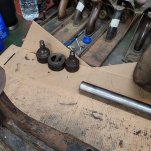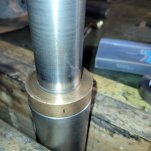Joe Michaels
Diamond
- Joined
- Apr 3, 2004
- Location
- Shandaken, NY, USA
Dundeeshopnut:
On the camelback drills I have seen/worked on, the ball thrust bearing was used at the bottom end of the quill to take the thrust load from drilling. The spindle, at the top of the quill usually has a set of thrust washers and adjusting nuts. At the top of the mainframe, the crown gear is usually seated on a thrust shim (washer). On really old drills, this would have been bronze, and on newer (if you could call ca 1917 newer), the thrust shim under the crown gear is reinforced phenolic. The thrust shim under the crown gear on my Cincinnati-Bickford camelback drill (1917 or thereabouts) is maybe 1/8-3/16" thick phenolic. On the Barnes camelback drill (1885-87), the thrust shim is bronze.
When I got my Cincinnati Bickford camelback drill, a good 25-30 years back, the ball thrust bearing at the lower end of the quill was pretty much as you describe. Whether someone let things get loose so some of the balls were lost, or whether due to wear in the thrust washer on the top end of the quill, the ball thrust bearing at the business end of the quill was shot. I took things apart, miked the journals and called Kaman Bearing (now Kaman Industrial Technologies or something like it). They matched me up with two INA ball thrust bearings. I replaced the bottom thrust bearing, and got rid of the thrust washers on the top of the quill in favor of a ball thrust bearing. There was enough space on the journal and adjusting nut/thread on the spindle to let me make that change. The new INA ball thrust bearings are enclosed with sheet metal shields, so the balls are captive. The move to get rid of the thrust washer on the top end of the quill made a world of difference as it let me put a little preload on both thrust bearings. With the original setup, having a thrust washer/thrust collar and adjusting nuts, there had to be some free play. I have not had to touch anything on that C-B drill in ages, just lube her up and put the belts back on (I take the leather flat belts off the pulleys when not in use) , dog down the job to the table and go to work.
The little Barnes camelback drill, old as it is, has bronze thrust washers. That little drill apparently had light use over the past nearly 140 years and is a nice, tight machine. I did not have to adjust the thrust collars on the spindle/quill. Still in good adjustment when I checked and powered that little drill up a few months ago.
On the camelback drills I have seen/worked on, the ball thrust bearing was used at the bottom end of the quill to take the thrust load from drilling. The spindle, at the top of the quill usually has a set of thrust washers and adjusting nuts. At the top of the mainframe, the crown gear is usually seated on a thrust shim (washer). On really old drills, this would have been bronze, and on newer (if you could call ca 1917 newer), the thrust shim under the crown gear is reinforced phenolic. The thrust shim under the crown gear on my Cincinnati-Bickford camelback drill (1917 or thereabouts) is maybe 1/8-3/16" thick phenolic. On the Barnes camelback drill (1885-87), the thrust shim is bronze.
When I got my Cincinnati Bickford camelback drill, a good 25-30 years back, the ball thrust bearing at the lower end of the quill was pretty much as you describe. Whether someone let things get loose so some of the balls were lost, or whether due to wear in the thrust washer on the top end of the quill, the ball thrust bearing at the business end of the quill was shot. I took things apart, miked the journals and called Kaman Bearing (now Kaman Industrial Technologies or something like it). They matched me up with two INA ball thrust bearings. I replaced the bottom thrust bearing, and got rid of the thrust washers on the top of the quill in favor of a ball thrust bearing. There was enough space on the journal and adjusting nut/thread on the spindle to let me make that change. The new INA ball thrust bearings are enclosed with sheet metal shields, so the balls are captive. The move to get rid of the thrust washer on the top end of the quill made a world of difference as it let me put a little preload on both thrust bearings. With the original setup, having a thrust washer/thrust collar and adjusting nuts, there had to be some free play. I have not had to touch anything on that C-B drill in ages, just lube her up and put the belts back on (I take the leather flat belts off the pulleys when not in use) , dog down the job to the table and go to work.
The little Barnes camelback drill, old as it is, has bronze thrust washers. That little drill apparently had light use over the past nearly 140 years and is a nice, tight machine. I did not have to adjust the thrust collars on the spindle/quill. Still in good adjustment when I checked and powered that little drill up a few months ago.












